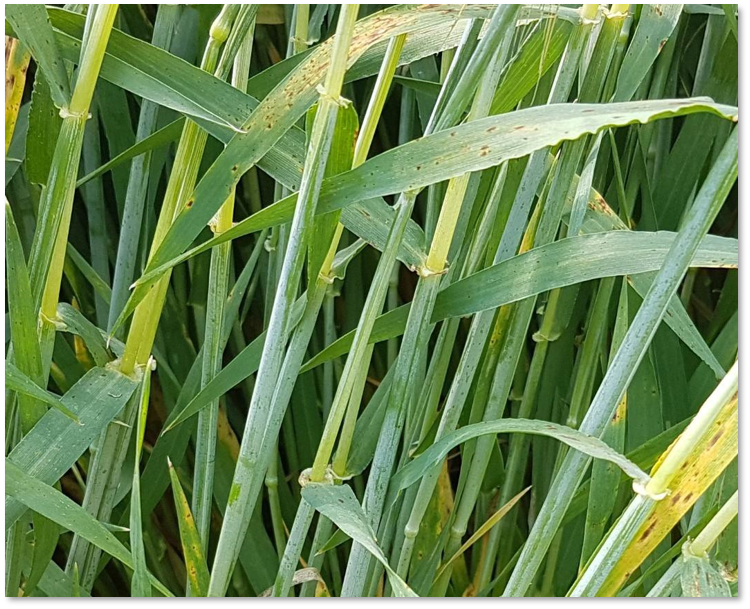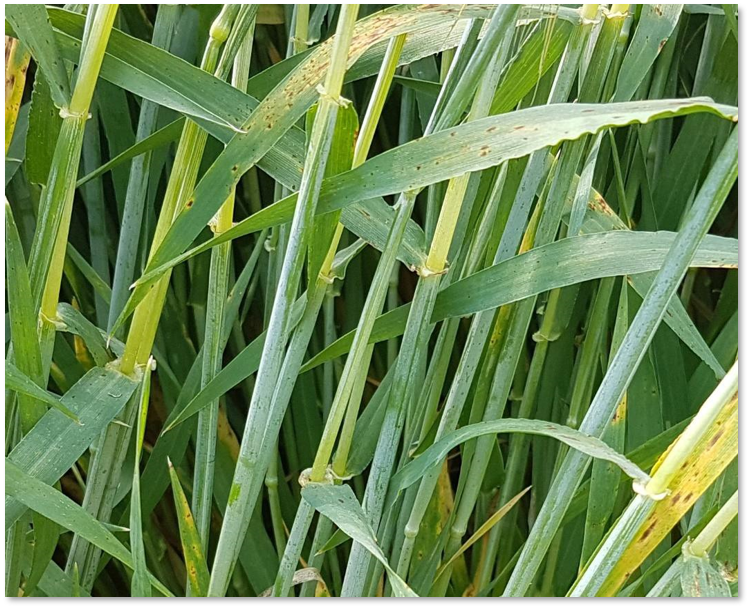 After a very long wait, new cereal fungicides and now coming along like London buses. CPM takes a look at the pipeline molecule from Syngenta, which is being hailed as a third-generation SDHI.
After a very long wait, new cereal fungicides and now coming along like London buses. CPM takes a look at the pipeline molecule from Syngenta, which is being hailed as a third-generation SDHI.
Adepidyn delivered an extra 1.2 t/ha compared with a range of other SDHI/azole combinations.
By Lucy de la Pasture
Following the current trend for trademarking ingredients, Syngenta has named its new fungicide technology Adepidyn – which contains the active ingredient pydiflumetofen. Currently under review in the UK by CRD, products containing the new ai are already registered in 29 countries outside the EU, including North and South America, says Syngenta UK fungicide portfolio manager, David Ranner. Approval in the UK isn’t expected before next year at the earliest.
“Adepidyn is an SDHI fungicide but is in a new group within the existing class of SDHIs. The molecule has a structure which confers long-lasting activity and with potency against a broad spectrum of diseases,” he explains.
The new chemistry is a unique representative within the N-methoxy-(phenyl-ethyl)-pyrazole-carboxamides group, one of ten different chemical groups that make up the SDHIs. It’s the structure of the Adepidyn molecule that gives it the properties that differentiate the new SDHI from others in the group in terms of potency against a broader spectrum of diseases and long-lasting activity, explains David.
“The new fungicide molecule contains distinct parts – the ethyl link with phenyl functional group at one end of the molecule is associated with long-lasting activity, and its pyrazole amide structure is associated with potency against key diseases,” he explains.
Syngenta believes the third generation SDHI will offer a step-change in performance against important cereal diseases, such as septoria in wheat and both net blotch and ramularia in barley, where it also provides good activity against rhynchosporium. Adepidyn also appears to offer activity against a wider range of pathogens than the previous two generations of SDHIs. Perhaps the most significant of these is fusarium head blight in wheat, highlights Syngenta fungicide technical manager, Jason Tatnell.
The comparative potency of Adepidyn compared with other SDHIS has been investigated by Syngenta by in vitro EC50 testing, using an EU database of field samples of Septoria which included field samples from the UK taken during 2020 and preceding years, he says.
“250-550 isolates were tested per SDHI in a lab-based in-vitro test using a liquid media/optical density analysis. The EC50 is the concentration in mg/l of the active ingredient required to reduce pathogen growth (optical density) by 50% = 50% ‘control’,” he explains. “This method gives a level playing field measure of relative potency.”
The results clearly demonstrate the step-change in potency against septoria compared with older SDHIs, he highlights. Jason says that as well as the promising potency results in lab-based studies, the superior performance of Adepidyn is demonstrated in field trials where high levels of septoria control are being seen.
“Trials have shown that an Adepidyn treatment applied at the important flag leaf or T2 timing produced clearly visible reductions in septoria compared with alternative SDHI/azole combinations, including newer chemistry,” he explains.
“More importantly, this super-power performance has been reflected in increased yields. In the high septoria pressure season of 2019, trials showed that T2 applications of Adepidyn delivered an extra 1.2 t/ha compared with a range of other SDHI/azole combinations. In 2020, it also delivered an average of an extra 0.55t/ha compared with newer SDHI/azole chemistry across a range of doses.
“Research by Harper Adams University College in 2020 showed that a T2 application gave significant reductions in both fusarium head blight and DON mycotoxin.”
Similarly encouraging results have been seen in barley trials, adds Jason, which have also shown T2 applications of an Adepidyn treatment have given clear reductions in net blotch, ramularia and the resulting high levels of disease control have resulted in very little brackling.
“Yield data from barley trials comparing Adepidyn with an alternative leading SDHI/azole combination showed it gave an average of an extra 0.4 t/ha – rising to an extra 0.7 t/ha on sites where disease pressure was high.
“Even in the absence of disease in barley, field trials still showed an average 0.4 t/ha yield uplift over other SDHI/azole combinations,” he says.
In all the trials, green leaf retention is one of the most noticeable attributes of the the new pipeline chemistry compared with both older and the most recent fungicide chemistry. “Field research in wheat has shown the stamina aspect of Adepidyn in terms of its ability to provide long lasting green leaf retention, which is the driver for yield – generating 0.15 t/ha per day extra GLA retention on flag leaf >37%.”
The spoiler for fungicide chemistry is always the ability of pathogens to adapt and become less sensitive to its effects and this is exactly what’s happening to other members of the SDHI group. So where does that leave Adepidyn?
Jason confirms that cross-resistance occurs between all the classes of chemistry within the SDHIs but points out that the results being generated in both the lab and the field are in the presence of the septoria strains currently found in field populations, not wild-types. That’s an indication of its superior potency, he believes, but the new chemistry will need to be protected by using partner products in fungicide programme.
Although Adepidyn has initially been submitted for UK approval in all cereals – wheat, barley, oats, rye and triticale – Syngenta hope registrations in other crops will follow, including for early blight (Alternaria spp.) in potatoes.
.




